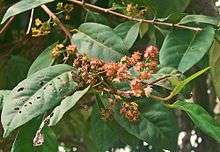Syzygium polyanthum
Syzygium polyanthum, with common names Indian bay leaf and Indonesian bay leaf,[2] is a species of plant in the family Myrtaceae, native to Indochina and Malaysia.[2] The leaves of the plant are traditionally used as a food flavouring, and have been shown to kill the spores of Bacillus cereus.[3]
| Syzygium polyanthum | |
|---|---|
 | |
| Scientific classification | |
| Kingdom: | Plantae |
| Clade: | Tracheophytes |
| Clade: | Angiosperms |
| Clade: | Eudicots |
| Clade: | Rosids |
| Order: | Myrtales |
| Family: | Myrtaceae |
| Genus: | Syzygium |
| Species: | S. polyanthum |
| Binomial name | |
| Syzygium polyanthum | |
| Synonyms[1] | |
| |
Description
The tree grows from lower to higher elevation up to 1400 meters. The tree can grow up to 25 meters of height. The leaf gives slightly bitter taste with astringent effect.[4]
Uses
The leaves may be used dried or fresh in the cuisine of Sumatra, Java, Madura, or Bali.[5] It is a common ingredient in nasi goreng, or fried rice.[6]
gollark: So instead of being bad™ and picking your political opinions based on either your social environment or "actual underlying beliefs", you can just read your opinion for the day off the calendar.
gollark: I also developed a political opinion calendar recently.
gollark: ("you" in the general sense)
gollark: If you elect me as supreme eternal world dictator for life, I will have been elected as supreme eternal world dictator for life.
gollark: gollark for supreme eternal world dictator for life, as they say.
References
| Wikimedia Commons has media related to Syzygium polyanthum. |
- The Plant List: A Working List of All Plant Species, retrieved 10 November 2015
- "Syzygium polyanthum". Germplasm Resources Information Network (GRIN). Agricultural Research Service (ARS), United States Department of Agriculture (USDA). Retrieved 10 November 2015.
- Lau, K.Y.; Rukayadi, Y. (2015), "Screening of tropical medicinal plants for sporicidal activity" (PDF), International Food Research Journal, 22 (1): 421–425
- Atlas tumbuhan obat Indonesia (in Indonesian). Niaga Swadaya. 2008-01-01. ISBN 9789796610655.
- Katzer, Gernot. "Spice Pages: Indonesian Bay-Leaf (Eugenia polyantha, Syzygium polyanthum, daun salam)". gernot-katzers-spice-pages.com. Retrieved 2017-03-02.
- Sanderson, Helen; Renfrew, Jane M. (2005). Prance, Ghillean; Nesbitt, Mark (eds.). The Cultural History of Plants. Routledge. p. 102. ISBN 0415927463.
This article is issued from Wikipedia. The text is licensed under Creative Commons - Attribution - Sharealike. Additional terms may apply for the media files.